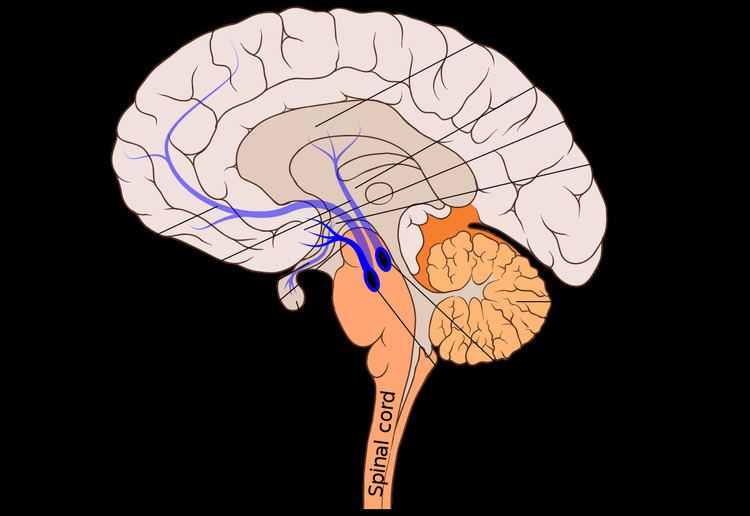 | ||
The mesolimbic pathway, sometimes referred to as the reward pathway, is a dopaminergic pathway in the brain. The pathway connects the ventral tegmental area, which is located in the midbrain, to the nucleus accumbens. The mesolimbic pathway releases dopamine into the nucleus accumbens, where dopamine neurotransmission increases motivation for rewarding stimuli (i.e., incentive salience), facilitates reinforcement and reward-related motor function learning, and may play a role in the subjective perception of pleasure. The dysregulation of the mesolimbic pathway and its output neurons in the nucleus accumbens plays a significant role in the development and maintenance of an addiction.
Contents
Anatomy
The mesolimbic pathway is a collection of dopaminergic (i.e., dopamine-releasing) neurons that project from the ventral tegmental area (VTA) to the nucleus accumbens (NAcc). It is one of the component pathways of the medial forebrain bundle, which is a set of neural pathways that mediate brain stimulation reward.
The VTA is located in the midbrain and consists of dopaminergic, GABAergic, and glutamatergic neurons. The nucleus accumbens is found in the ventral striatum and is composed of medium spiny neurons. It is subdivided into limbic and motor subregions known as the NAcc shell and NAcc core. The medium spiny neurons in the nucleus accumbens receive input from both the dopaminergic neurons of the VTA and the glutamatergic neurons of the hippocampus, amygdala, and medial prefrontal cortex. When they are activated by these inputs, the medium spiny neurons' projections release GABA onto the ventral pallidum.
Function
The mesolimbic pathway regulates incentive salience, motivation, reinforcement learning, and fear, among other cognitive processes. The mesolimbic pathway is involved in motivation cognition. Depletion of dopamine in this pathway, or lesions at its site of origin, decrease the extent to which an animal is willing to go to obtain a reward (e.g., the number of lever presses for nicotine or time searching for food). Dopaminergic drugs are also able to increase the extent an animal is willing to go to get a reward, and the firing rate of neurons in the mesolimbic pathway increases during anticipation of reward. Mesolimbic dopamine release was once thought to be the primary mediator of pleasure, but is now believed to have only a minor role in pleasure perception.
Clinical significance
This pathway plays a central role in the neurobiology of addiction; in particular, a drug addiction is defined as the compulsive use of a drug that is rewarding (i.e., activate this pathway), despite adverse consequences. It is also implicated in schizophrenia and depression. Addiction, schizophrenia, and depression all involve distinct structural changes within this pathway.
Other dopamine pathways
The other dopamine pathways are:
